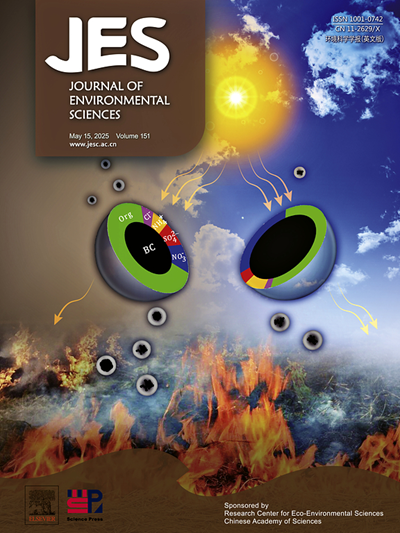微生物介导的土壤溶解有机氮转化途径:对地下水氮污染风险缓解的影响
IF 5.9
2区 环境科学与生态学
Q1 ENVIRONMENTAL SCIENCES
引用次数: 0
摘要
土壤溶解有机氮(DON)化合物的分子特征和转化过程的探索是至关重要的,因为它们影响着DON组分向地下水的浸出。然而,分子转化途径在很大程度上仍然是未知的领域。因此,对不同土地利用土壤中微生物处理的DON转化途径进行了全面研究。利用先进的傅立叶变换离子回旋共振质谱和16S rRNA测序技术,完成了DON成分和微生物群落的测定。这些方法与FAPROTAX数据库和网络分析协同集成。结果表明,DON是主要的氮组分,在这些土壤中表现出显著的组成差异。主要成分包括木质素类和缩合芳香化合物,其芳香性和缩合度各不相同。关键微生物属,包括Solirubrobacter, 67-14和芽孢杆菌,被确定为DON分解和矿化的关键。功能注释显示,大量的细菌与芳香族化合物的分解、脂肪族非甲烷烃的降解和纤维素的水解有关。网络分析强调DON转化过程的相互联系和合作方面,N呼吸与各种降解活动之间存在显著关系。微生物功能与DON组分之间的相关性分析强调了DON组分转化的不同机制。将高分子量DON转化为低分子量DON的精心安排的过程促进了潜在的地下水浸出,强调了理解和管理微生物介导的DON转化途径以减轻地下水污染风险的必要性。本文章由计算机程序翻译,如有差异,请以英文原文为准。

Microbial-mediated soil dissolved organic nitrogen transformation pathways: Implications for groundwater nitrogen contamination risk mitigation
The exploration of the molecular characteristics and transformation processes of soil dissolved organic nitrogen (DON) compounds is paramount, as they affect the leaching of DON components into groundwater. Nevertheless, the molecular transformation pathways remain largely uncharted territories. Hence, a comprehensive study of microbial-medicated DON transformation pathways across various land use soils was conducted. The determination of DON components and microbial communities was accomplished utilizing advanced techniques, namely fourier transform ion cyclotron resonance mass spectrometry and 16S rRNA sequencing. These methodologies were synergistically integrated with the FAPROTAX database and network analysis. The results showed that DON emerged as the predominant nitrogen fraction, displaying significant variations in composition across these soils. The dominant constitutes comprised lignin-like and condensed aromatic compounds, varying in their aromaticity and condensation degrees. Key microbial genera, including Solirubrobacter, 67–14, and Bacillus, were identified as crucial for DON decomposition and mineralization. Functional annotation revealed abundant bacteria associated with the breakdown of aromatic compounds, the degradation of aliphatic non-methane hydrocarbons, and the hydrolysis of cellulose. Network analysis emphasized the interconnected and cooperative aspects of DON transformation processes, with notable relationships between N respiration and various degradation activities. Correlation analysis between microbial functions and DON components emphasized distinct mechanisms involved in the transformation of DON components. The orchestrated process of converting high-molecular-weight DON into low-molecular-weight counterparts facilitates potential leaching into groundwater, emphasizing the need for understanding and managing microbial-mediated DON transformation pathways to mitigate groundwater contamination risk.
求助全文
通过发布文献求助,成功后即可免费获取论文全文。
去求助
来源期刊

Journal of Environmental Sciences-china
环境科学-环境科学
CiteScore
13.70
自引率
0.00%
发文量
6354
审稿时长
2.6 months
期刊介绍:
The Journal of Environmental Sciences is an international journal started in 1989. The journal is devoted to publish original, peer-reviewed research papers on main aspects of environmental sciences, such as environmental chemistry, environmental biology, ecology, geosciences and environmental physics. Appropriate subjects include basic and applied research on atmospheric, terrestrial and aquatic environments, pollution control and abatement technology, conservation of natural resources, environmental health and toxicology. Announcements of international environmental science meetings and other recent information are also included.
 求助内容:
求助内容: 应助结果提醒方式:
应助结果提醒方式:


